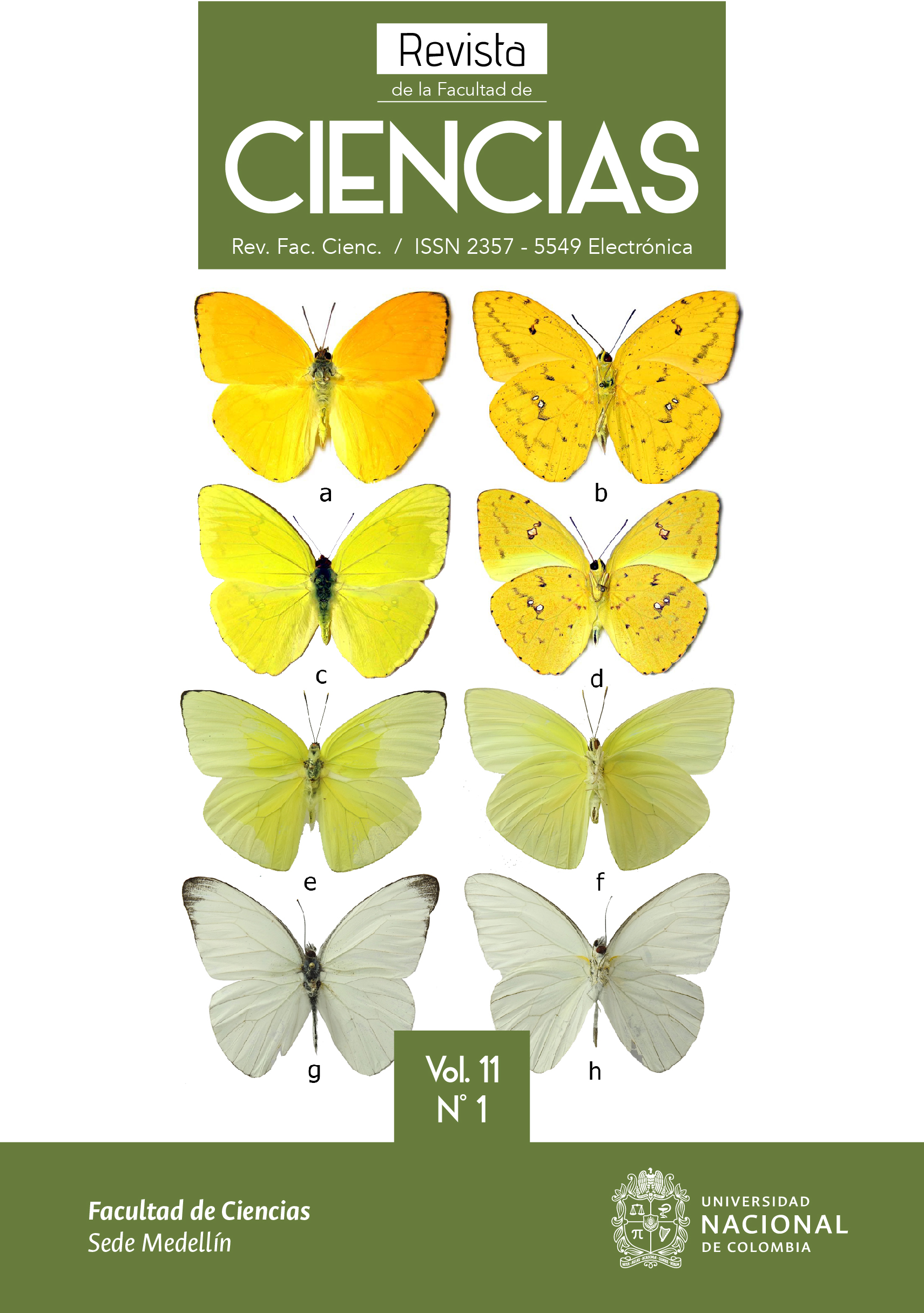Publicado
Versiones
- 2022-01-01 (2)
- 2022-01-01 (1)
DESEMPEÑO DEL MODELO DE LOTKA-VOLTERRA Y HOLLING APLICADO A SISTEMAS PRESA-DEPREDADOR
PERFORMANCE OF THE LOTKA-VOLTERRA AND HOLLING MODEL APPLIED TO PREY-PREDATOR SYSTEMS
DOI:
https://doi.org/10.15446/rev.fac.cienc.v11n1.90452Palabras clave:
colinealidad, condición crítica, curvas diferenciales, reducción paramétrica (es)collinearity, critical condition, differential curves, parametric reduction (en)
Descargas
En este trabajo se demuestra computacionalmente la condición crítica del modelo Lotka-Volterra, partiendo de la suposición formal de crecimiento presa-depredador en relación 1:1, utilizando el método Runge-Kutta y asumiendo valores hipotéticos de las constantes fijas positivas A (tasa de crecimiento de la presa), B (tasa a la que los depredadores destruyen a la presa), C (tasa de mortalidad de los depredadores), y D (tasa a la que los depredadores aumentan al consumir presas respectivamente); interactuando entre sí en el ecosistema, de forma tal que se estimó la dependencia de las variables x(presa) e y(depredador) en función del tiempo a través de los diferenciales dx/dt y dy/dt. Se consideró también un modelo depredador-presa de respuesta funcional de tipo II de Holling, observando que el depredador presentó una saturación y fue necesario un período de tiempo para la captura, según las curvas diferenciales de trayectorias y campos de dirección; el resultado concluyente es la variable presa que se superpone a la variable depredador, ajustándose los valores a una colinealidad en función del tiempo. Este estudio tuvo como objetivo implementar el Modelo de Lotka-Volterra y Holling para ser aplicado a sistemas presa-depredador.
In this work, the critical condition of the Lotka-Volterra model was demonstrated, starting from the formal assumption of prey-predator growth in a 1: 1 ratio, using the Runge-Kutta method and assuming hypothetical values of the positive fixed constants A (growth rate prey), B (rate at which predators destroy prey), C (death rate of predators), and D (rate at which predators increase by consuming prey, respectively); interacting with each other in the ecosystem, in such a way that the dependence of the variables x (prey) and y (predator) as a function of time was estimated through the dx / dt and dy / dt differentials. A Holling type II functional response predator-prey model was considered, observing that the predator had saturation and a period of time was necessary for the capture, according to the differential curves of trajectories and direction fields; the conclusive result is the prey variable that is superimposed on the predator variable, adjusting the values to a collinearity as a function of time. This study aimed to implement the Lotka-Volterra and Holling Model to be applied to prey-predator systems.
Referencias
Abobakr, A.H., Hussien, H.S. & Mansour, M.B.A. (2020). On Wave Patterns in a Spatially Extended Holling–Tanner Model. Int. J. Appl. Comput. Math 6, 93. https://doi.org/10.1007/s40819-020-00854-x
Arora, C & Kumar, V. (2020) Dynamics of Predator–Prey System with Migrating Species and Disease in Prey Population. Differ Equ Dyn Syst (2020). https://doi.org/10.1007/s12591-020-00529-5
Dengata, J & Ma, S. Modified Chebyshev. (2020) collocation method for delayed predator–prey system. Adv Differ Equ, 313. https://doi.org/10.1186/s13662-020-02769-9
Ito, H.C., Dieckmann, U. & Metz, J.A.J. (2020). Lotka–Volterra approximations for evolutionary trait-substitution processes. J. Math. Biol. 80, 2141–2226. https://doi.org/10.1007/s00285-020-01493-y
Khan, T. & Chaudhary, H. (2020). Estimation and Identifiability of Parameters for Generalized Lotka-Volterra Biological Systems Using Adaptive Controlled Combination Difference Anti-Synchronization. Differ Equ Dyn Syst. https://doi.org/10.1007/s12591-020-00534-8
Li, X & Yin, G. (2016), Logistic models with regime switching: permanence and ergodicity, Journal of Mathematical Analysis and Applications, vol. 441, no. 2, 593–611. DOI: https://doi.org/10.1016/j.jmaa.2016.04.016
Liu, M & Bai, C. (2016), Dynamics of a stochastic one-prey two-predator model with L ́evy jumps, Applied Mathematics and Computation, vol. 284, 308–321. DOI: https://doi.org/10.1016/j.amc.2016.02.033
Liu, M & Bai, C. (2016), Analysis of a stochastic tritrophic food chain model with harvesting, Journal of Mathematical Biology, vol. 73, no. 3, 597–625. DOI: https://doi.org/10.1007/s00285-016-0970-z
Lv, W., Wang, F. & Li, Y. (2018). Adaptive finite-time tracking control for nonlinear systems with unmodeled dynamics using neural networks. Adv Differ Equ, 159 (2018). https://doi.org/10.1186/s13662-018-1615-x
Ma, T, Meng, X & Chang, Z. (2019), Dynamics and optimal harvesting control for a stochastic one predator two prey time delay system with jumps, Complexity, vol. 2019, 19-20 DOI: https://doi.org/10.1155/2019/5342031
Mandal, P.S., Kumar, U & Garain, K. (2020). Allee effect can simplify the dynamics of a prey-predator model. J. Appl. Math. Comput.63, 739–770. https://doi.org/10.1007/s12190-020-01337-4
Meng, X, Li, F & Gao, S. (2018), Global analysis and numerical simulations of a novel stochastic eco-epidemiological model with time delay, Applied Mathematics and Computation, vol. 339, 701–726. DOI: https://doi.org/10.1016/j.amc.2018.07.039
Meng, Y & Zhang, W. (2020). Properties of Traveling Wave Fronts for Three Species Lotka–Volterra System. Qual. Theory Dyn. Syst. 19, 67. https://doi.org/10.1007/s12346-020-00404-2
Mavinga, R. (2017), Bifurcation from infinity for reaction-diffusion equations under nonlinear boundary conditions. Proc. Roy. Soc. Edinburgh Sect. 147-3, 649-671. DOI: https://doi.org/10.1017/S0308210516000251
Surendran, A., Plank, M.J. & Simpson, M.J. (2020). Small-scale spatial structure affects predator-prey dynamics and coexistence. Theor Ecol. https://doi.org/10.1007/s12080-020-00467-6
Xie, X., Xue, Y & Chen, J. (2016). Permanence and global attractivity of a nonautonomous modified Leslie-Gower predator-prey model with Holling-type II schemes and a prey refuge. Adv Differ Equ, 184. https://doi.org/10.1186/s13662-016-0892-5
Yan, W. (2020). Traveling Waves in a Stage-Structured Predator–Prey Model with Holling Type Functional Response. Bull. Malays. Math. Sci. Soc. https://doi.org/10.1007/s40840-020-00953-4
Zu, L, Jiang, D, O’Regan, D & Ge, B. (2015), Periodic solution for a non-autonomous Lotka-Volterra predator-prey model with random perturbation, Journal of Mathematical Analysis and Applications, vol. 430, no. 1, 428–437. DOI: https://doi.org/10.1016/j.jmaa.2015.04.058
Wang, H & Zou, C. Propagation Direction of the Traveling Wave for the Lotka–Volterra Competitive Lattice System. J Dyn Diff Equat (2020). https://doi.org/10.1007/s10884-020-09853-4
Wang, Y & Zou, X. (2020). On a Predator–Prey System with Digestion Delay and Anti-Predation Strategy. J Nonlinear Sci 30, 1579–1605. https://doi.org/10.1007/s00332-020-09618-9
Cómo citar
APA
ACM
ACS
ABNT
Chicago
Harvard
IEEE
MLA
Turabian
Vancouver
Descargar cita
Licencia
Derechos de autor 2022 Revista de la Facultad de Ciencias

Esta obra está bajo una licencia internacional Creative Commons Atribución-NoComercial-SinDerivadas 4.0.
Los autores o titulares del derecho de autor de cada artículo confieren a la Revista de la Facultad de Ciencias de la Universidad Nacional de Colombia una autorización no exclusiva, limitada y gratuita sobre el artículo que una vez evaluado y aprobado se envía para su posterior publicación ajustándose a las siguientes características:
1. Se remite la versión corregida de acuerdo con las sugerencias de los evaluadores y se aclara que el artículo mencionado se trata de un documento inédito sobre el que se tienen los derechos que se autorizan y se asume total responsabilidad por el contenido de su obra ante la Revista de la Facultad de Ciencias, la Universidad Nacional de Colombia y ante terceros.
2. La autorización conferida a la revista estará vigente a partir de la fecha en que se incluye en el volumen y número respectivo de la Revista de la Facultad de Ciencias en el Sistema Open Journal Systems y en la página principal de la revista (https://revistas.unal.edu.co/index.php/rfc/index), así como en las diferentes bases e índices de datos en que se encuentra indexada la publicación.
3. Los autores autorizan a la Revista de la Facultad de Ciencias de la Universidad Nacional de Colombia para publicar el documento en el formato en que sea requerido (impreso, digital, electrónico o cualquier otro conocido o por conocer) y autorizan a la Revista de la Facultad de Ciencias para incluir la obra en los índices y buscadores que estimen necesarios para promover su difusión.
4. Los autores aceptan que la autorización se hace a título gratuito, por lo tanto renuncian a recibir emolumento alguno por la publicación, distribución, comunicación pública y cualquier otro uso que se haga en los términos de la presente autorización.
5. Todos los contenidos de la Revista de la Facultad de Ciencias, están publicados bajo la Licencia Creative Commons Atribución – No comercial – Sin Derivar 4.0.
MODELO DE CARTA DE PRESENTACIÓN y CESIÓN DE DERECHOS DE AUTOR





















